| |
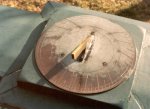 |
Long Island |
New York |
USA |
Horizontal Dial |
Dial 100 |
| A bronze circular horizontal dial about 18 inches in diameter. At the edge of the dial set in concentric rings are the hour lines, half hour lines, quarter hour and five minute marks. Hours are in Roman numerals from 5am to 7pm. Has a thick brass gnomon. |
| |
| |
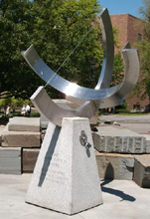 |
Ithaca |
New York |
USA |
Equatorial Dial |
Dial 99 |
| This 650 pound equatorial has a gear adjustment to rotate the equatorial time ring using a knob on the side of the pillar. This allows correction for the Equation of Time (sun's apparent variability in crossing the noon meridian and enables the instrument to read clock time, making this a very precise instrument. The gearing rusted in 1980 and was refurbished: "The heart of the sundial's functionality, a roundish steel disc called a cam, was also replaced with a stainless steel, slightly better-functioning one, connected to an hour and minute scale by small, stainless steel cables via a pair of precisely designed pulleys." Thus the mechanical adjustment compensates for the sun's irregular motion called the Equation of Time and shows civil not solar time. |
| |
| |
|
Morristown |
New Jersey |
USA |
Horizontal Dial |
Dial 98 |
| 12.75' dia. Granite with Bronze numerals 10" long. Commonly called the Washington Memorial Dial. An inscription on the octagonal base indicates this memorial is a tribute from the Daughters of the American Revolution. |
| |
| |
 |
Isles of Shoals |
New Hampshire |
USA |
Armillary Sphere |
Dial 97 |
| Simple armillary dial about 2 feet in diameter sits on a triangular cut stone pedestal. The equatorial band has raised Arabic numbers at each hour. The hours are adjusted by 42 minutes to correct for zone time. The gnomon is an arrow rod of traditional fashion. The base supporting the armillary is a small hemisphere globe, with a map of the continents plainly visible. The armillary cuts the globe at the Greenwich hour line facing due north. The triangular granite stone pedestal was once part of the Captain John Smith Monument, commemorating him as the discoverer of the Isles of Shoals in 1610. |
| |
| |
|
Kalamazoo |
Michigan |
USA |
Horizontal Dial |
Dial 96 |
| Large circular bench ca 25' in diameter forms ring with hour markings. Aluminum or stainless steel gnomon. Relatively new. |
| |
| |
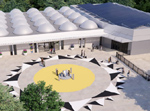 |
Worcester |
Massachusetts |
USA |
Equatorial Dial |
Dial 95 |
| The equatorial dial is a 6-ft (2m) cylinder segment, approx 1-ft (1m) across. Gnomon is intentionally omitted. Visitor stands centered in the curve of the cylinder and places finger on crossbar as directed. Shadow of finger indicates the time. |
| |
| |
 |
Collinsville |
Illinois |
USA |
Sun Alignment |
Dial 94 |
| At the Cahokia Mounds is a woodhenge discovered in the early 1960's during excavations and has been reconstructed. There are a series of wood posts in multiple circles that indicate various solar events such as the solstices, equinoxes, and what are thought to be special festival days related to the agricultural cycle of the region. Critical posts also align with the mounds of the site on certain dates. The outer of 3 circles of posts has a diameter of 410 feet with 48 equidistant posts. Each post is about 20 feet high. Equinox and solstice sunrise observations are held at the site on the Sunday morning closest to the event. |
| |
| |
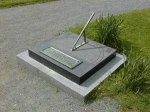 |
Halifax |
Nova Scotia |
Canada |
Horizontal Dial |
Dial 93 |
| Bronze horizontal dial on a granite base. Has Roman numerals showing time noting "Mean solar time in Halifax is 1 hour and 14 minutes behind Atlantic Standard Time." |
| |
| |
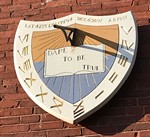 |
Milton |
Massachusetts |
USA |
Vertical Dial |
Dial 92 |
| A vertical south facing dial made of painted mahogany with an aluminum gnomon. The dial is in the shape of a shield 3 foot tall by 2 1/2 foot wide, following the seal of the Milton Academy. Around the edge are the hours in Roman numeral. An Equation of Time correction table is now missing, but does not detract from the beauty of the dial. The dial is kept in excellent condition in red, blue and gold motif. |
| |
| |
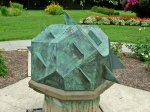 |
Baltimore |
Maryland |
USA |
Polyhedral Dial |
Dial 91 |
| Bronze on stone. Renovated 1904 and again in 1994 (by George McDowell.). It is a 17-facet hemispherical compendium dial. Has facets calibrated for local solar time for Baltimore, Jeddo [Tokyo], Honolulu, Sitka, Pitcairn Islands, San Francisco, Cape Cod, Rio Jancito, London, Fernano Po, Cape Town, Jerusalem, and Calcutta. Has a polar and vertical dial for Baltimore time. Built in 1892 by Peter Hamilton, 19th C Baltimore stonecutter, became president of the company which supplied granite for the Library of Congress building. Repaired and reset in 1904. Reworked in 1993. The original pedestal remains, consisting of a stone pillar carved to resemble the trunk of a tree. |
| |
| |
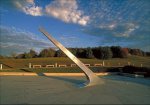 |
Frankfort |
Kentucky |
USA |
Horizontal Dial |
Dial 90 |
| The Kentucky Vietnam Veterans Memorial features a 7090 square foot plaza with a monumental 86x68 foot horizontal dial of granite slabs with a 14.6 foot high gnomon of welded stainless steel plates. |
| |
| |
 |
Orlando |
Florida |
USA |
Pillar Dial |
Dial 89 |
| Reconstruction of a 4-sided pillar dial. |
| |
| |
 |
Detroit |
Michigan |
USA |
Armillary Sphere |
Dial 88 |
| A 6 foot diameter wrought iron armillary with equatorial and polar rings. Hour numerals are missing. Cast zodiacal signs are present in fair condition on exterior of equatorial ring. Dial is on a decaying brick circular pedestal at the center of a concrete and brick base. Rings are heavily marked with graffiti. The dial sits atop a brick and mortar pedestal in poor condition. |
| |
| |
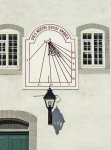 |
Quebec City |
Quebec |
Canada |
Vertical Dial |
Dial 87 |
| Vertical dial on a board, about 1.5m high by 1 m wide. White with red lettering. It is placed above a doorway on an interior courtyard of the old Seminary, founded in 1663 by Mgr de Laval. The building now houses the architecture school of the Laval University. Although the school and Seminary buildings are private, access is available to the courtyard. |
| |
| |
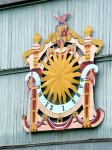 |
Stratford |
Connecticut |
USA |
Vertical Dial |
Dial 86 |
| Large vertical dial at the Shakespeare Festival Theatre entrance. The dial is formed around a large circular sunburst with Roman numerals at the edge. Gnomon is missing. Dial declines east and is non-functional for this position and location. Above the dial is a shield. |
| |
| |
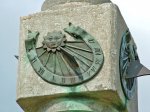 |
Storrs |
Connecticut |
USA |
Pillar Dial |
Dial 85 |
| Waugh memorial dial. Not oriented on cardinal points. It was rotated to avoid tree and adjacent building shadows. Gift of Mr. & Mrs. Kenneth Lynch Sr., the Alumni Association, and funds raised for the purpose. The stone pillar is 12 ft. high. Constructed by the firm of Kenneth Lynch & Sons. |
| |
| |
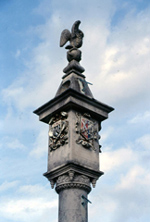 |
Pomfret |
Connecticut |
USA |
Pillar Dial |
Dial 84 |
| A 22 ft. high stone pillar dial built by William Ross Carpenter as a replica of the famous Charles Turnbull dial of Corpus Christi College in England dating from 1577. The pillar dial, called the Pelican dial, has multiple dials of various types. The Carpenter replica built in 1912 was restored in 1987. Ornate dial furniture with multiple inscriptions. A complex masterpiece. See the NASS Compendium Vol. 2 No. 1 for more details. |
| |
| |
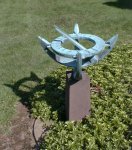 |
Newington |
Connecticut |
USA |
Horizontal Dial |
Dial 83 |
| Bronze horizontal ring, suspended by curved semi-circles, with gnomon rising from the center toward the North. "...you can see resemblances to an anchor, a gimbal, and a mariner's compass" says designer Searle Lansing-Jones. |
| |
| |
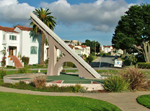 |
San Francisco |
California |
USA |
Horizontal Dial |
Dial 82 |
| Built in 1913 as a promotion for a housing development that was once a racetrack, this dial boasted (incorrectly) that at 34 feet in diameter and a gnomon style 28 feet in length, it was the largest known dial in the western world. Nevertheless it gathered much publicity and newspaper articles thanks to the Urban Realty Improvement Co. The company put out a brochure "The Sundial at Ingleside Terrace with Comments on Homes" using the sundial as a lure to attract home buyers to the newly constructed residential neighborhood. On Oct 10, the same day the Panama Canal was opened, a festive gala was held at the sundial dedication attended by more than 1500 people. Photos show young girls dancing around a small pool that surrounded the gnomon. A light (visible in several early photos) dangled from the tip of the gnomon. Bronze statues of seals were originally in the pool, but by 1920 the pool was filled with concrete and the seals were gone. Today the pool area is painted green. |
| |
| |
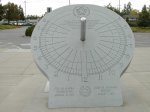 |
Aurora |
Colorado |
USA |
Equatorial Dial |
Dial 81 |
| A large Erickson Monument equatorial polar dial 6 feet in diameter made of light granite with a 3 inch steel rod as gnomon. The dial was dedicated as part of the bicentennial celebrations in July 1976. Hour lines from 4am to 8pm. Time is graduated by half-hour, quarter hours and 5 minute marks. Designed to be read from the upper surface in Spring/Summer, from the under side in Fall/Winter. A plaque provides the Equation of Time to convert solar time to watch time. Dial has both the bicentennial emblem and the city seal of the city of Aurora. |
| |
| |
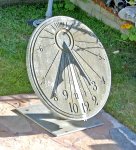 |
San Diego |
California |
USA |
Vertical Dial |
Dial 80 |
| This dial was originally owned and installed at Sea World in San Diego but was sold and purchased by Verlyn Kuhlmann. A 39 inch diameter reclining vertical dial of cast concrete with a 20 inch long steel gnomon. Dial reclines about 50°. Includes cast hour lines with Arabic numerals and longitude correction. A separate plaque provides instructions and an EOT graph. The dial is mounted on a 24 inch square aluminum base plate and short column support. |
| |
| |
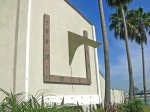 |
Huntington Beach |
California |
USA |
Vertical Dial |
Dial 78 |
| A 7x8 foot direct south facing vertical dial of wood with metal gnomon on the masonry stucco side of a fire station building. Hour lines are painted on wood planks bolted to the side of the building. Metal Arabic DST hour numerals are mounted to the wood planks. Longitude correction is not included and there is no EOT correction or instructions offered but dial is accurate when both corrections are applied. |
| |
| |
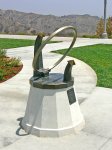 |
Los Angeles |
California |
USA |
Equatorial Dial |
Dial 77 |
| A bronze equatorial ring dial with taut wire gnomon on concrete pedestal. Ring is inscribed with hour, ten-minute and minute lines. Plaque states the dial indicates correct watch time so observatory staff periodically rotates clamped ring to correct for EOT, longitude and DST. Dial is located adjacent to the Astronomers Monument atop which is a large bronze armillary. The monument recognizes Hipparchus, Copernicus, Galileo, Kepler, Newton and Hershel. The sundial was originally built into the base of the Astronomers Monument but was relocated a few feet to the south during the 2002-2006 remodeling to allow visitors to more closely approach the dial. The dial sits atop a concrete pedestal. |
| |
| |
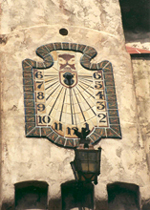 |
Death Valley |
California |
USA |
Vertical Dial |
Dial 76 |
| Prospector and con man Walter Scott convinced Chicago millionaire Albert Johnson to invest in his gold mine in the Death Valley area. The mine was a fraud, but Johnson began building his Spanish Revival Villa in 1922 that continued until the stock market crash of 1929. Martin de Dubovay was the architect, Mat Roy Thompson was the engineer and head of construction, and Charles Alexander MacNeilledge was the designer |
| |
| |
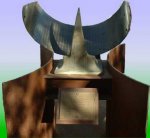 |
Tempe |
Arizona |
USA |
Equatorial Dial |
Dial 75 |
| An equatorial dial designed by R. Newton Mayall with a "curved triangular gnomon over a curved face approximately 12-in (.3m). wide. Tells the day of the year and standard time noon." Has a plaque explaining the Equation of Time. |
| |
| |
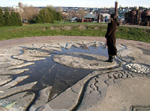 |
Seattle |
Washington |
USA |
Analemmatic Dial |
Dial 74 |
| 27-ft (8m) circle containing a fanciful analemmatic dial made of bronze and concrete with countless embedded items. Seattle Sundial Trails notes "It requires more than a casual look to recognize the paving that tops Kite Hill as a sundial. At first glance, it seems as if the high tide washed over a bed of fresh concrete, leaving lots of marine creatures and wave prints behind.....The structure is colored concrete, with many interesting inlaid objects scattered throughout, including a bronze bear claw, a ceramic crab, pieces of pottery and glass and shells, etc. Many features are in bronze (such as some hour numerals and the [zodiac walkway] on which one stands.... Bronze casts of three pairs of footprints are those of Greening, the (anonymous) donor of the piece, and the donor’s dog! There are, however, so many inlaid objects and the hour numerals are so stylized that the dial pattern is somewhat obscured." At the center of the dial is a large yin-yang symbol, made from light and dark concrete. Within this is the zodiac walkway to stand for casting the hour's shadow. However normal dates have given way to elongated bronze band loops around a wavy center line using zodiac signs to indicate the months. For example: Equinoxes are indicated by Aries and Libra while the summer solstice is the Tropic of Cancer and winter solstice is Tropic of Capricorn. |
| |
| |
 |
Johnson |
Vermont |
USA |
Horizontal Dial |
Dial 71 |
| One of Kate Pond's first dials, a winning design for an 18 foot diameter dial that now resides on the University of North Vermont - Johnson green. Concrete, Stainless Steel. On the ground concrete paths mark the N-S and E-W axes. The gnomon is a 3 inch stainless steel pipe 9 feet long attached to a concrete base. The hours are marked with 1 foot diameter Vermont granite stones, and at the cardinal points are larger stone markers. Kenneth Leslie, Assistant Professor of Art, remarked, " I have the idea of a student sitting against the North marker, reading a newspaper for a noon class, and knowing it's time to leave when the shadow crosses his paper." |
| |
| |
|
Jerico |
Vermont |
USA |
Horizontal Dial |
Dial 70 |
| 50 foot diameter horizontal dial of steel, concrete and stone. Called "Polaris". The gnomon is 10 foot high forming a stone pyramid. As the sun shines through a hole at the center, an analemma is traced on the ground. Markers identify equinox sunrises and solstice sunsets. The dial was built by Kate Pond and her students. See NASS Compendium Vol 1, No. 2, May 1994. |
| |
| |
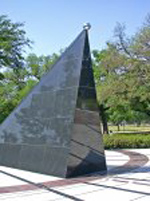 |
Houston |
Texas |
USA |
Horizontal Dial |
Dial 68 |
| Monumental size sundial with a black granite gnomon shaped as a tetrahedral with a small silver ball nodus at the peak. The 12 foot gnomon has a slope of 29.72 deg matching the latitude of Houston. The dial face is white granite with black granite stripes for hour lines, each marked by Roman numerals.granite stripes for hour lines. Along each hour line are markers for month pairs when the shadow of the nodus passes over. These markers are connected by thin declination lines, including the limits of summer and winter solstice and the straight line showing the equinox. |
| |
| |
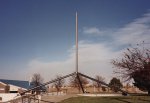 |
Amarillo |
Texas |
USA |
Obelisk or Vertical Gnomon |
Dial 67 |
| The Centennial Time Tower begins as a tetrahedron of stainless steel pipes each 18 feet long. Then a central pipe towers to the sky, giving an overall height of about 50 feet. The Time Tower is situated on a circle about 100 feet in diameter. The dial was erected for the hundredth anniversary of the discovery of Helium. Each individual pipe is a time capsule filled with helium. The plaque under the center of the tower shows when each one is to be opened. |
| |
| |
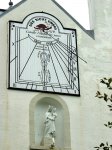 |
Trois Rivieres |
Quebec |
Canada |
Vertical Dial |
Dial 66 |
| A declining vertical dial approximately 6 feet wide and 8 feet tall of painted wood. Diol declines 58? west of south. Dial includes a two-lined analemma noon mark that shows noon corrected for EOT. Hour lines with Roman numerals show local time from 10 AM to 7 PM. Dial is located about 30 feet high on a wall, above an alcove with a statue of the Virgin Mary. The gnomon length is correct for the shadow of the tip to fall on the noon mark. Dial furniture includes a lunar crescent and a depiction of a beaver carrying a tree branch, in a classic French tradition and similar to dials of Zarbula's overall design. |
| |
| |
|
Stanstead |
Quebec |
Canada |
Horizontal Dial |
Dial 65 |
| A horizontal dial "sculptural triptych" called "Zig-Zag". Three steel pipes 8x15x13 feet define the sundial. The shadow from its highest point will run along the lower horizontal section exactly E-W at the equinoxes. Stainless steel bolts on the horizontal section serve as hour markers to that time is recorded throughout the year, with the first section of the zigzag serving as the gnomon. The dial-sculpture was funded in part by a 1991 award of a Vermont Community Fund Grant. See NASS Compendium Vol. 1 No. 2, May 1994 |
| |
| |
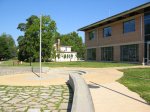 |
Oberlin |
Ohio |
USA |
Sun Alignment |
Dial 63 |
| When is a flag pole more than a flag pole? When it has cement walkway curved for the summer solstice, a path for the winter solstice and a distinguishing straight cement line for the spring and fall equinox. This dial has no hour markers, and is intended to show the seasons. The tip of the flag pole will follow these lines at the appropriate day of the season. |
| |
| |
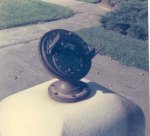 |
London |
Ontario |
Canada |
Heliochronometer |
Dial 62 |
| A brass Pilkington-Gibbs heliochronomer aligned to the celestial equator. Rotate the helioscope until the sun shines from the upper hole to the lower plate, then read the time from an accompanying dial. The Pilkington-Gibbs dial includes a patented cam mechanism to adjust for the Equation of Time. |
| |
| |
 |
Great Falls |
Montana |
USA |
Equatorial Dial |
Dial 61 |
| A monumental bow-string equatorial dial of curved 4x6 inch welded steel I-beams forming a 14 foot diameter equatorial arc. Stainless steel Roman hour numerals 5 AM to 7 PM are welded to the arc. Metal for the dial was once used at Rainbow Dam and was formed and welded at Rainbow Powerhouse. |
| |
| |
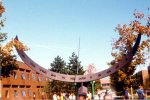 |
Rochester |
New York |
USA |
Equatorial Dial |
Dial 60 |
| A large 40 foot equatorial dial. The dial band is about 5 feet wide with raised Roman numerals at each hour mark. The gnomon is a rod approximately 15 feet long, ingeniously suspended by wires at the center of the dial. No shadow of the support wires can be seen, just the line of the gnomon appears on the dial band. |
| |
| |
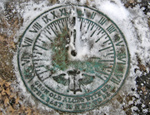 |
Highland Park |
Illinois |
USA |
Horizontal Dial |
Dial 55 |
| A cast bronze horizontal dial with hour, half-hour and quarter-hour lines and Roman hour numerals for 5AM to 7PM. Dial face symbol depicts a winged hourglass. |
| |
| |
 |
St. Louis |
Missouri |
USA |
Vertical Dial |
Dial 54 |
| This modernistic vertical south declining dial was designed by Mel Meyer and installed in 1989. The dial is an 8 by 10 foot stainless steel sundial with ribbed hour lines. No numerals are used. The gnomon is a solid triangle 3.5 inches wide by 85 inches high. |
| |
| |
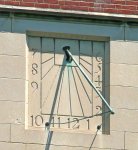 |
Brunswick |
Maine |
USA |
Vertical Dial |
Dial 53 |
| A set of three declining vertical dials each approximately 3x4 foot of carved Indiana Limestone set into the east, south and west facades of Hubbard Hall. Dial faces include hour lines and Arabic hour numerals. Each bronze gnomon rod is additionally supported at its end. The dials are not corrected for longitude and there is no EOT correction provided. With corrections, all three dials tell accurate time. The building south wall declines approximately 18? west of south. |
| |
| |
 |
Gaithersburg |
Maryland |
USA |
Polar Dial |
Dial 51 |
| Briggs Commemorative Sundial. One of the more complex and elaborate ones in the US. The dial plate lies parallel to the earth's axis of rotation. The dial has three gnomons. The upper and lower point out Eastern Standard time, the middle one indicates local apparent (solar) time throughout the year. A copy of the brochure is in the NASS Archives. |
| |
| |
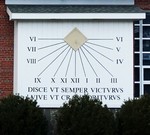 |
Stow |
Massachusetts |
USA |
Vertical Dial |
Dial 48 |
| The dial was originally high on the south gable of a stone building called the Apple Barn that was located on the grounds of Stow's Center School. Extensive renovations and new buildings were done in 2010 and the Apple Barn itself had to be demolished. The dial was moved to the south-facing wall of the new school's southernmost wing. The dial has hour lines from 6am to 6pm with Roman numerals at each hour. The gnomon radiates from a plain diamond in the center of the dial and the dial face is constructed of white painted clabbered wood. |
| |
| |
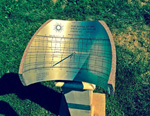 |
Heber City |
Utah |
USA |
Cylindrical Dial |
Dial 47 |
| A 10 inch wide, cylindrical-segment equatorial dial 8 inches high, fabricated from a section of large PVC pipe. The dial face is aluminum sheet bonded to the PVC pipe and marked by photochemical engraving with hour lines showing analemmas to correct for EOT; hour lines are corrected for longitude and show both standard and daylight saving Arabic hour numerals. Winter and summer solstices and equinoxes are marked. The gnomon is a pointed brass rod. Instructions for use are included on dial face. |
| |
| |
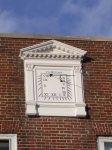 |
Cambridge |
Massachusetts |
USA |
Vertical Dial |
Dial 45 |
| Painted Dial |
| |
| |
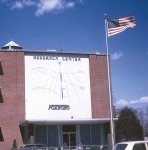 |
Foxboro |
Massachusetts |
USA |
Vertical Dial |
Dial 43 |
| Very large vertical dial mounted above the entrance to the Foxboro Research Center. With solstice and equinox lines and a noon analemma. |
| |
| |
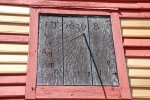 |
Danvers |
Massachusetts |
USA |
Vertical Dial |
Dial 42 |
| An east- declining vertical wood dial above the main doorway of the Rebecca Nurse House. Rebecca Nurse was a victim of the Salem witch trials in 1692. The House was restored in 1909 and it is believed this dial was added at that time; there is no evidence the house originally had a sundial. |
| |
| |
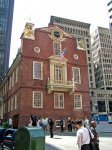 |
Boston |
Massachusetts |
USA |
Vertical Dial |
Dial 41 |
| Once high on east facing wall of the Old State House, was a vertical declining sundial originally built in 1713. The 6x4 foot dial was just above the third story window. It was restored by R.N. Mayall in 1957. But the background became a faded blue and hour lines were hard to see. At least the Roman numerals along edge were clearly visible. In the upper left corner of dial, just above the gnomon,was a small yellow sun. |
| |
| |
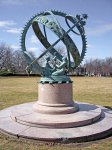 |
Andover |
Massachusetts |
USA |
Armillary Sphere |
Dial 40 |
| A very large and ornate armillary sphere, approximately 8 feet in diameter. Sculpted by Paul Manship in 1928 and cast by Alexis Rudier Fondeur in Paris. The armillary has large figures inside the sphere at the base and the equatorial circle has signs of the zodiac in raised metalwork. The dial sits atop a well proportioned light granite pillar that is about 3 foot high and 4 foot diameter. |
| |
| |
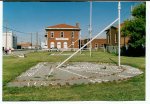 |
Dodge City |
Kansas |
USA |
Horizontal Dial |
Dial 39 |
| Two horizontal dials side by side, one for Central Standard Time and one for Mountain Standard Time. The CST dial shows hour lines for 7 AM to 7 PM, the MST dial shows 6 AM through 6 PM. Corrected for longitude. Each dial is approximately 13 meters in diameter. In front of the dials is a large concrete plaque with the equation of time and analemma. The analemma is represented as summer on top and late months (Feb, Jul) on right. This is not the way it would be viewed in the traditional series of photos nor is it the way a shadow would be traced. The width is exaggerated, presumably to allow a better reading of the minutes of time. The paint is peeling badly. |
| |
| |
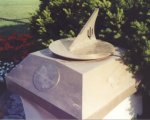 |
Bloomington |
Indiana |
USA |
Horizontal Dial |
Dial 38 |
| A small horizontal dial, about 18 inches in diameter. The dial plate is tilted 2 deg to the horizon to allow water run-off. However, more unusual is the base that contains a hand crank connected to a scalloped drum that tilts the entire dial to adjust for the Equation of Time. The drum is rotated to the current date and the drum edge pushes a cam that tilts the plane of the horizontal face so that standard time is indicated to within half a minute. The dial is actually mounted on an equatorial axis. Since 1979 the dial has gone into a state of disrepair and is overgrown by bushes. |
| |
| |
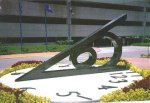 |
Orlando |
Florida |
USA |
Horizontal Dial |
Dial 37 |
| This plain dial formed on a concrete base has an elegant gnomon, designed with an interior curve and oval. But alas, don't go to Florida to find it. Sometime in 2013 as Harcourt closed its Florida office, the new tenet had no use for the sundial and had it scheduled for demolition. |
| |